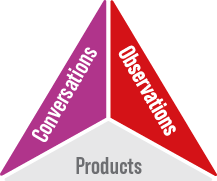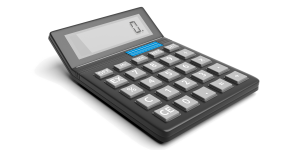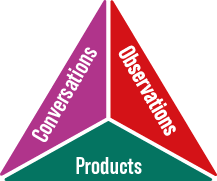F1. Money and Finances
Demonstrate an understanding of the value and use of Canadian currency.
Learning Situation: How Much Does It Cost?
Duration: 50 minutes
Overview
In this learning situation, students will expand their knowledge of a simple cash transaction by estimating and calculating the change to be given for a simulated purchase in a realistic and familiar context.
Note: This learning situation can be subdivided into several small activities to allow students to deepen their knowledge and make connections with other concepts.
| Overall Expectation | Specific Expectation |
|---|---|
| F1. Financial Literacy
Demonstrate an understanding of the value and use of Canadian currency. |
F1.1 Estimate and calculate the change required for various simple cash transactions involving whole-dollar amounts and amounts of less than one dollar. |
| Preferred High-Impact Instructional Practices in Mathematics | Description |
|---|---|
|
Learning Goals, Success Criteria and Descriptive Feedback |
Before beginning this learning situation, it is essential to make the learning goals, based on the curriculum expectations and content, explicit so that they are known and understood by all students. This will ensure that students are aware of the learning goals of the lesson. The success criteria can then be developed and understood through a variety of instructional strategies, such as using examples of student work, co-constructing the success criteria or self-assessing how the criteria have been met. These strategies allow for student engagement and a shared understanding of the steps needed to achieve the learning goals. It is important to make the learning goals and success criteria visible by posting them in the classroom for students to refer to throughout the lesson. Descriptive feedback related to the criteria provides the specific information students need to achieve the intended learning goals. By providing descriptive feedback on multiple occasions, educators help students develop the skills to assess their own learning and reflect on the criteria. In this learning situation, a good time for descriptive feedback is during the Active Learning phase. Students practice paying for items with different combinations of bills or coins determining the change which would be given. Students work and communicate in small groups, and, with thoughtful questioning, educators check for understanding and direct students to the criteria to adjust or justify their work. During the Review phase, some solutions may require descriptive feedback from the educator to ensure that the student has the necessary support to revise their thinking to apply to a new context. |
|
Problem-Solving Tasks and Experiences |
This learning situation has many entry points, and all students will be able to participate and propose solutions using their strategies, as well as their critical and creative thinking. The flow of this learning situation can be differentiated by providing work teams with individualized purchase amounts that will make the task accessible, yet challenging. |
|
Math Conversations |
By planning lessons like this, which emphasize collaboration and groupwork, the math conversations are ongoing. These conversations allow students to express themselves and react to the mathematical ideas presented. The role of educators will be to ask open-ended, thought-provoking questions to stimulate thinking and allow for multiple responses. This interaction through questioning must be carefully planned to highlight key concepts, skills, or specific representations to promote student progress. Educators are encouraged to anticipate students' questions and answers in order to make the exercise even more strategic (for example, by anticipating some common errors). As soon as the learning situation begins, educators should ask questions that are accessible to all students and encourage them to share their ideas in the class group. As students are engaged in solving the problem, questioning and discussion should promote their reasoning and justification as a group and develop their critical thinking. During Review, the questioning should support rich mathematical conversation in the whole group and provide educators with the opportunity to assess student understanding of the concepts being learned. |
|
Flexible Groupings |
Flexible groupings can foster collaboration and give students the opportunity to participate in rich math conversations, learn from each other, and evolve their mathematical thinking. These structures allow students to work independently of the educator, while benefiting from the support of their peers. It is the intentional combination of large group, small group, pair, and individual work that can foster a rich mathematical learning environment. For this learning situation, the initial scenario can be done in small diverse groups of two or three, so that students can share strategies and be inspired by other ideas. During the Active Learning, small groups of two or three are preferable to promote the participation of each student. Review in the whole class group allows students to hear the ideas of others, while bringing their own ideas to the discussion. The choice of flexible groupings can be adapted according to the needs of your class group. |
Prior Knowledge and Skills
To be able to complete this learning situation, students must be able to:
- Represent, compose, and decompose whole numbers from 0 to 1000, using a variety of tools and strategies.
- Skip count to 50 by 1s, 2s, 5s, and 10s, using a variety of tools and strategies.
- Round whole numbers to the nearest 10 and 100 in a variety of contexts.
- Demonstrate an understanding of algorithms for adding and subtracting whole numbers by making connections to and
describing the way other tools and strategies are used to add and subtract. - Use mental math strategies, including estimation, to add numbers that sum to 1000 or less and to subtract whole numbers
equal to or less than 1000, using a variety of tools and algorithms.
Learning Goals
At the end of this learning situation, the student will be able to:
- Estimate and calculate the cost of an item.
- Estimate and calculate the payment as well as the change to be returned when simulating a purchase, in cash.
- Communicate their mathematical reasoning using learned vocabulary.
- Apply the steps of a money transaction in another problem-solving exercise simulating a purchase.
Possible Success Criteria Based on the Achievement Chart
| Skill | Success Criteria |
|---|---|
|
Knowledge and Understanding |
The student understands estimation strategies. |
|
Thinking |
The student chooses strategies for adding and subtracting coins and bills. |
|
Communication |
The student communicates their mathematical reasoning using symbols, drawings, explanations, and manipulatives. |
|
Application |
The student solves money problems that simulate a monetary transaction in a variety of contexts, first using the concept of estimation and then applying the various steps of a monetary transaction. |
Materials
- pencil case
- pencil
- calculator
- labels
- markers
- large chart paper or whiteboard
- Canadian play money coin set
Mathematical Vocabulary
purchase, cash, round up, estimate, count, calculate, hundred, cost, total, dollar, sale, change to be returned, payment, wallet, money transaction, amount of money
Before Learning (Warm-Up)
Duration: 25 minutes
Assessment can be carried out through…
Present the scenario below to the students:
On the first day of school, Didier notices that a classroom has several school items used during math lessons. He wonders how much some of these items might have cost.
Pre-label a pencil with a price of 52¢, a pencil sharpener with a price of 47¢ (amounts that are less than $1), a calculator
with a price of $8, and a globe with a price of $16 (amounts that are more than $1).
|
First Monetary Transaction |
Second Monetary Transaction |
||
|
Pencil: 52¢ |
 |
Calculator: $8 |
 |
|
Pencil sharpener: 47¢ |
 |
Globe: $16 |
 |
Explain to students that they will perform two simple monetary transactions (one at a time) with these items to simulate a
purchase.
Group students randomly into teams of two or three.
Give each team the coins and bills shown below and tell them that these will be their wallet content for the two transactions.

Present the following information:
- First monetary transaction
Didier asks himself the following question: If we had to buy a pencil that costs 52¢ or a pencil sharpener that costs 47¢, how much money could we give to the store clerk to make the payment if we have the following coins and bills in our wallet? Also, what change would we get back? - Second monetary transaction
Didier asks himself the following question: If we had to buy a calculator that costs $8 or a globe that costs $16, how much money could we give to the store clerk to make the payment if we have the following coins and bills in our wallet? Also, what change would we get back?
Ask students questions in order to deepen their thinking about the possibilities of making the payment. Encourage students to pay with different combinations in order to practice estimating and calculating the change to be given.
Possible questions include:
- Which coin or bill is worth less than the price of the pencil? the price of the pencil sharpener? the price of the calculator?
the price of the globe? - Which coin or bill is worth more than the price of the pencil? the price of the pencil sharpener? the price of the calculator?
the price of the globe? - Do we have enough cash to pay for the pencil and sharpener? to pay for the calculator and globe? How do you know?
- How can you calculate the change to be given? By adding? By subtracting?
Ask students to estimate the total cost of each of the two money transactions and determine the amount of money needed to pay. Then, ask students to estimate the change to be given as a result of each purchase. Explain to students that depending on the amount given to make the payment, the change to be given may vary.
When students have completed the estimation, ask them to calculate the total cost of both monetary transactions.
To help students estimate and calculate, revisit mental math strategies in a class setting, such as adding, using compensation, decomposing, and adding parts, looking for compatible numbers, or other personal algorithms. Encourage mathematical conversation in the groups by asking students to communicate the strategies they used to solve the problem.
Note: When using cash, actual costs must be rounded to the nearest 5¢, as the 1¢ coin has not been in circulation since 2013; however, if paying with a debit or credit card or by electronic transaction, there is no need to round to the nearest 5¢ and no change will be required.
Ask students to round up the total cost of the first transaction to the nearest 5¢. If necessary, provide examples of rounding to
students. For example, the ruler costs 44¢ - round up to 45¢ to determine its cash cost. The pencil sharpener costs 47¢ - round to
45¢ to determine its cash cost. If the pencil costs 52¢, is its price closer to 50¢ or 55¢?
Finally, ask students to calculate the change to be given and determine how it might be given, that is, with what coins. Repeat the same steps to solve the problem with the purchase of the calculator and globe. Circulate and encourage students to communicate their ideas and represent their work and thinking in different ways.
Active Learning (Exploration)
Duration: 25 minutes
Assessment can be carried out through…
Group students into small teams and invite them to take a pencil case of their choice. Have them choose 4 or 5 items from the pencil case and mark a price on them that is less than $1 or dollar value.
Circulate and validate students' choices so that there is a variety of prices and different amounts to make new monetary transactions.
Ask students to model the purchase of items in order to experience new money transaction situations. First, ask students to choose an item costing less than $1. Then, ask students to choose 2 or 3 items with whole dollar prices to estimate and calculate the cost of the purchase and the change to be given.
Repeat the activity several times, changing roles and varying items and prices.
Ask students to leave a record of their reasoning and calculations on a large piece of paper or erasable surface.
Possible Answers
I choose a pencil sharpener for 47¢. Since 47 is close to 50, I estimate that the total cost will be about 50¢. I could pay with a $1 coin and receive 50¢ in change. Since $1 = 100¢, I can do 100 - 50 to estimate the change to be given.
Since I am using cash, I have to round down the total cost to the nearest 5 cents, 47 is closer to 45 than 50, so the actual cost of my purchase will be 45¢. Paying with a $1 coin, I calculate the change to be given by determining the difference between 45 and 100. I can use addition or subtraction to do this:
Addition
\(\displaylines{\begin{align}&45¢ + 5¢ \; \; = 50¢ \\ &50¢ + 25¢ = 75¢ \\ &75¢ + 25¢ = 100¢ \ \mathrm{or} \ $1 \end{align}}\)
The change due is \(5¢ + 25¢ + 25¢, \ so\ 55¢\).
Subtraction
\(100¢ - 40¢ = 60¢ \)
\(60¢ - 5¢ = 55¢ \)
The change to be given is 55¢.
I will make change with 2 quarters and a nickel.
|
Possible Observations |
Possible Interventions |
|
Students have difficulty estimating the cost of 2 or more items to complete a simple monetary transaction. |
|
|
Students have difficulty calculating the change to be given during the purchase simulation. |
|
|
Students seem to choose overly simple amounts (for example, multiples of 5) for the prizes chosen. |
|
Review
Duration: 30 minutes
Assessment can be carried out through…
When teams are finished, have students circulate and observe the other teams' representations.
Ask students questions to encourage them to communicate their mathematical reasoning.
Possible questions include:
- How did you select the coin(s) or bill(s) to give to the clerk to make the payment?
- Are there different combinations of coins or bills that a person can use to pay for a purchase? Is one way better than another?
- What strategies did you use to calculate the change to be given? Did you show your thinking?
- Did everyone in your group use the same strategy?
- Have you noticed similar thinking demonstrated in your calculations and the calculations of the other teams?
different thinking? Did you see something you might try next time to solve a similar problem? - Do you feel you have met the learning goals?
- How did you feel when you compared your representation with others? Were you anxious or apprehensive because of the
different responses? If so, how could I better support you to improve your resilience and self-confidence? What strategies
could you use if such a situation occurs again?
Consolidation of Learning
- Use play money to make simulated monetary transactions for class rewards or sports equipment at recess.
- Taking into account the interests of the class, change the context of the money transactions, for example: drawings of
baked goods made by the children can be exchanged for play money. Each small group of students can imagine themselves
in their own café, restaurant or specialty store.
Links to Other Curriculum Expectations
Number
B1.1 Read, represent, compose, and decompose whole numbers up to and including 1000, using a variety of tools and strategies, and describe various ways they are used in everyday life.
B1.3 Round whole numbers to the nearest ten or hundred, in various contexts.
B2.3 Use mental math strategies, including estimation, to add and subtract whole numbers that add up to no more than 1000, and explain the strategies used.
B2.4 Demonstrate an understanding of algorithms for adding and subtracting whole numbers by making connections to and describing the way other tools and strategies are used to add and subtract.
B2.5 Represent and solve problems involving the addition and subtraction of whole numbers that add up to no more than 1000, using various tools and algorithms.
Algebra
C2.2 Determine whether given sets of addition, subtraction, multiplication, and division expressions are equivalent or not.
C2.3 Identify and use equivalent relationships for whole numbers up to 1000, in various contexts.
Differentiated Instruction and Universal Design for Learning
The activity can be modified to meet different student needs.
- Provide visual supports (reference) for students to identify coins and their value with greater ease.
- When setting up the scenario, suggest that the student start with a $1 coin to purchase the 52¢ pencil and a $10 bill to
purchase the $8 calculator. - Provide students with a hundreds chart, Rekenrek, or other manipulatives that make it easier for them to count.
- Depending on the students' interests, change the items to be sold (games, balls, drawings, etc.). By varying the items to be
sold, there will be an impact on the prices.
For an Extra Challenge
- Ask students to create other scenarios for the rest of the class to solve.
- Encourage students to use only certain coins or bills in money transactions (for example, only $1, 25¢, and 10¢ coins can
be used). - Ask the student to find a combination of coins or bills that includes as many or as few coins as possible, or a specific
number of coins and bills. Given some constraints, the student will have to think of possible combinations of coins and bills
within the guidelines (for example, use 5 coins to get 75¢).
